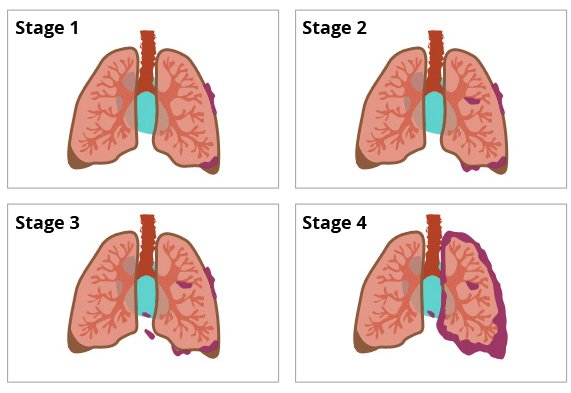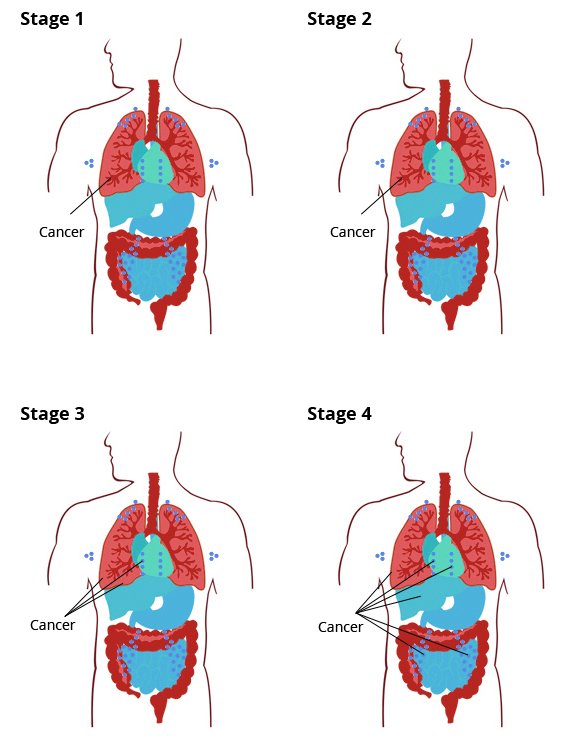Mesothelioma Stages of Progression

Staging is a method of evaluating the progress of cancer in a patient. It looks at the mesothelioma and the extent to which it has developed and its possible spread to other parts of the body.
Table of Contents
Since pleural mesothelioma occurs most frequently and has been studied the most, it is the only mesothelioma for which a staging classification exists.
Several medical approaches are utilized to determine the staging of mesothelioma, including x-rays, CT scans, and MRI scans. The advancement, extent, and spread of the cancer determines the stage of the mesothelioma, and determines the treatment and outlook for the patient.
There are three recognized clinical staging systems for evaluating the spread and extent of pleural mesothelioma:
The Butchart System has been the standard staging method for most cancers, including mesothelioma.
The TNM Staging system is beginning to be used by major cancer centers as a more accurate method for specifically evaluating mesothelioma.
The Brigham System is one of the latest methods for the staging of mesothelioma.
Butchart Staging System The staging system used in the past for mesothelioma is the Butchart system.
This system is based mainly on the extent of the primary tumor mass, and divides mesotheliomas into stages I through IV.
Many doctors will still use these Mesothelioma Stages

- Stage I: Mesothelioma is present within the right or left pleura, and may also involve the lung, pericardium, or diaphragm (the muscle separating the chest from the abdomen) on the same side.
- Stage II: Mesothelioma invades the chest wall or involves the esophagus (food passage connecting the throat to the stomach), heart, or pleura on both sides. The lymph nodes in the chest may also be involved.
- Stage III: Mesothelioma has penetrated through the diaphragm into the peritoneum (lining of the abdominal cavity). Lymph nodes beyond those in the chest may also be involved.
- Stage IV: There is evidence of distant metastases (spread through the bloodstream to other organs).
TNM Staging System
Another staging system has recently been developed by the International Mesothelioma Interest Group and adopted by the American Joint Committee on Cancer (AJCC).
This is a TNM system, similar to staging systems used for most other cancers.
- T stands for tumor (its size and how far it has spread to nearby organs)
- N stands for spread to lymph nodes
- M is for metastasis (spread to distant organs).
In TNM staging, information about the tumor, lymph nodes, and metastasis is combined in a process called stage grouping to assign a stage described by Roman numerals from I to IV.
Major cancer centers are beginning to use this system instead of the Butchart staging because it more accurately depicts the extent of tumor.

- Stage I: Mesothelioma involves either the right or left pleura lining the chest. It has only spread to the outer lining of the lung in, at most, a few small spots. It has not yet spread to the lymph nodes.
- Stage II: Mesothelioma involves either the right or left pleura lining the chest and has spread from the lining of the chest into 1) the outer lining of the lung or 2) the diaphragm or 3) into the lung itself.
- Stage III: Mesothelioma involves either the right or left pleura lining the chest and has spread into 1) the first layer of the chest wall, or 2) the fatty part of the mediastinum, or 3) a single place in the chest wall or 4) the outer covering layer of the heart or 5) lymph nodes anywhere in the same side of the chest.
- Stage IV: Mesothelioma involves either the right or left pleura lining the chest and has spread 1) into the chest wall, either muscle or ribs, or 2) through the diaphragm, or 3) into any organ contained in the mediastinum (esophagus, trachea, thymus, blood vessels), or 4) into the spine, or 5) across to the pleura on the other side of the chest, or 6) through the heart lining or into the heart itself, or 7) into the brachial plexus (nerves leading to the arm), or 8) into lymph nodes outside that side of the chest, or 9) spread to other organs through the bloodstream.
The Brigham System
The Brigham System is the latest system and stages mesothelioma according to resectability (the ability to surgically remove) and lymph node involvement.
- Stage I: surgically removable tumor and no lymph node spread.
- Stage II: surgically removable tumor with lymph node disease.
- Stage III: not surgically removable because tumor extends into the chest wall, to the heart, or through the diaphragm into the peritoneum (abdominal lining). Lymph nodes outside the chest may or may not have disease in them.
- Stage IV: disease spread to other parts of the body.
Your doctors may utilize one or more of the above staging systems to evaluate the extent of the mesothelioma, and identify appropriate treatment options.
If you or someone you love has been diagnosed with mesothelioma , let our highly qualified mesothelioma lawyers at Belluck Law, LLP work for you and your family. Visit our office in the City of New York today.